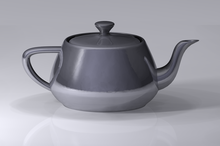Computer graphics is a sub-field of computer science which studies methods for digitally synthesizing and manipulating visual content. Although the term often refers to the study of three-dimensional computer graphics, it also encompasses two-dimensional graphics and image processing.

Computer graphics studies manipulation of visual and geometric information using computational techniques. It focuses on the mathematical and computational foundations of image generation and processing rather than purely aesthetic issues. Computer graphics is often differentiated from the field of visualization, although the two fields have many similarities.
Connected studies include:
Applications of computer graphics include:
There are several international conferences and journals where the most significant results in computer graphics are published. Among them are the SIGGRAPH and Eurographics conferences and the Association for Computing Machinery (ACM) Transactions on Graphics journal. The joint Eurographics and ACM SIGGRAPH symposium series features the major venues for the more specialized sub-fields: Symposium on Geometry Processing,[1] Symposium on Rendering, Symposium on Computer Animation,[2] and High Performance Graphics.[3]
As in the rest of computer science, conference publications in computer graphics are generally more significant than journal publications (and subsequently have lower acceptance rates).[4][5][6][7]
A broad classification of major subfields in computer graphics might be:
The subfield of geometry studies the representation of three-dimensional objects in a discrete digital setting. Because the appearance of an object depends largely on its exterior, boundary representations are most commonly used. Two dimensional surfaces are a good representation for most objects, though they may be non-manifold. Since surfaces are not finite, discrete digital approximations are used. Polygonal meshes (and to a lesser extent subdivision surfaces) are by far the most common representation, although point-based representations have become more popular recently (see for instance the Symposium on Point-Based Graphics).[8] These representations are Lagrangian, meaning the spatial locations of the samples are independent. Recently, Eulerian surface descriptions (i.e., where spatial samples are fixed) such as level sets have been developed into a useful representation for deforming surfaces which undergo many topological changes (with fluids being the most notable example).[9]
Geometry subfields include:
The subfield of animation studies descriptions for surfaces (and other phenomena) that move or deform over time. Historically, most work in this field has focused on parametric and data-driven models, but recently physical simulation has become more popular as computers have become more powerful computationally.
Animation subfields include:
Rendering generates images from a model. Rendering may simulate light transport to create realistic images or it may create images that have a particular artistic style in non-photorealistic rendering. The two basic operations in realistic rendering are transport (how much light passes from one place to another) and scattering (how surfaces interact with light). See Rendering (computer graphics) for more information.
Rendering subfields include:
Bitmap Design / Image Editing
Vector drawing
Architecture
Video editing
Sculpting, Animation, and 3D Modeling
Digital composition
Rendering
Other applications examples
Industrial labs doing "blue sky" graphics research include:
Major film studios notable for graphics research include: